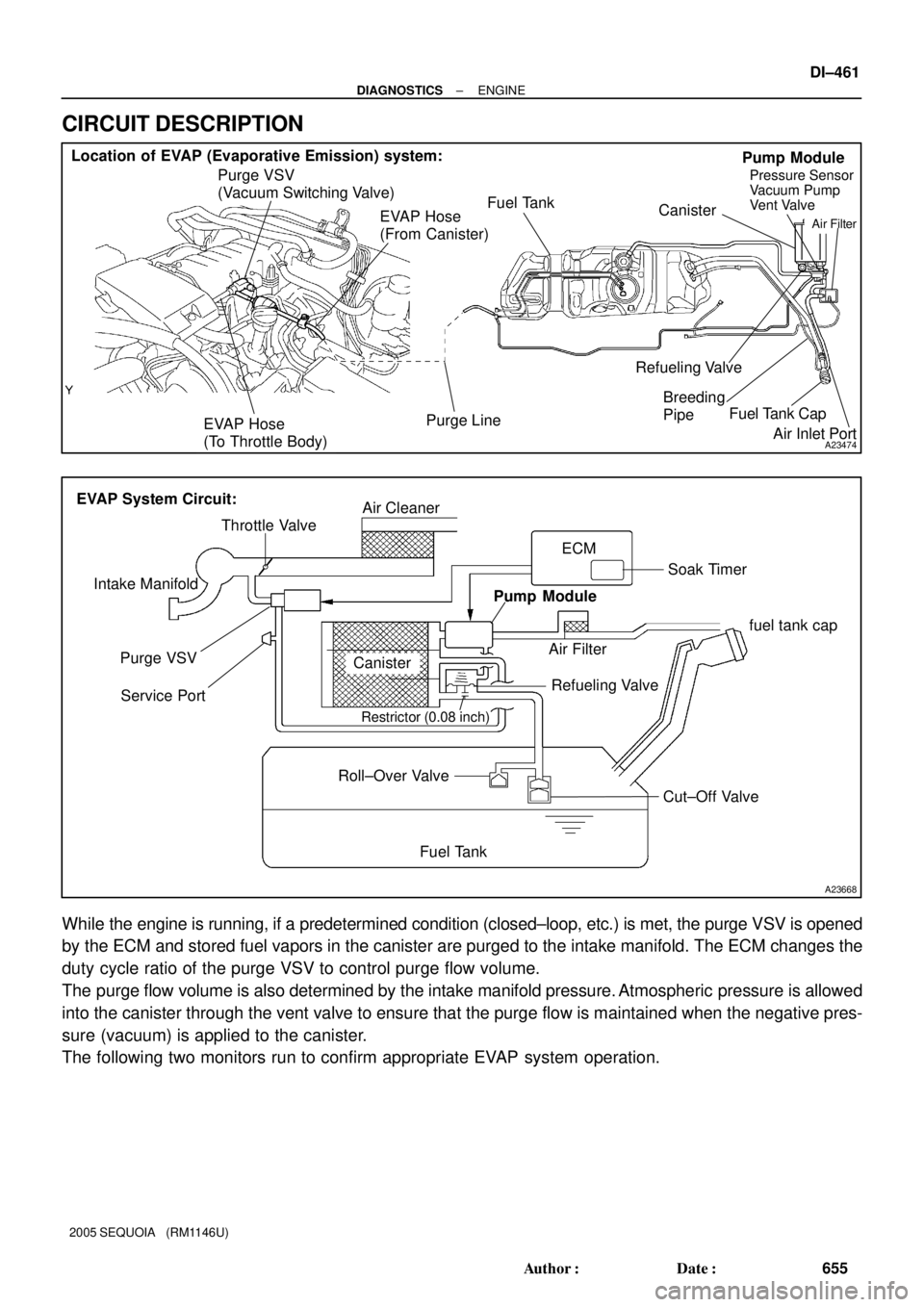Page 657 of 4323

+25 %
±12.5 %
More than 3.35 V
Less than 3.0 V
1
A/F Sensor (Sensor 1)
Output Voltage
Injection volume
Output voltage
HO2 Sensor (Sensor 2)
Output VoltageMain Suspected
Trouble Areas
OK
+25 %
±12.5 %
More than 3.35 V
Less than 3.0V
Injection volume
Output voltage
+25 %
±12.5 %
More than 0.55 V
Less than 0.4V
Injection volume
Output voltage
A/F sensor+25 %
±12.5 %
More than 0.55 V
Less than 0.4V
Injection volume
Output voltage
+25 %
±12.5 %
Injection volume
Output voltage
NG
+25 %
±12.5 %
Injection volume
Output voltage
NG
+25 %
±12.5 %
Injection volume
Output voltage
NG
+25 %
±12.5 %
Injection volume
Output voltage
NG OK
OK
OK
Almost
no reaction
'
Almost
no reaction Almost
no reaction
Almost
no reaction
Case
2
3
4
A/F sensor circuit A/F sensor heater
HO2 sensor
HO2 sensor circuit HO2 sensor heater
(Air±fuel ratio extremely
lean or rich)Injector
Gas leakage from
exhaust system Fuel pressure
± DIAGNOSTICSENGINE
DI±455
649 Author�: Date�:
2005 SEQUOIA (RM1146U)
NOTICE:
The Air±Fuel Ratio (A/F) sensor has an output delay of a few seconds and the Heated Oxygen (HO2)
sensor has a maximum output delay of approximately 20 seconds.
�Following the A/F CONTROL procedure enables technicians to check and graph the voltage outputs
of both the A/F and HO2 sensors.
�To display the graph, select the following menu items on the tester: DIAGNOSIS / ENHANCED OBD
II / ACTIVE TEST / A/F CONTROL / USER DATA / AFS B1S1 and O2S B1S2, and press the YES but-
ton and then the ENTER button followed by the F4 button.
HINT:
�DTC P2A00 may be also set, when the air±fuel ratio is stuck rich or lean.
�A low A/F sensor voltage could be caused by a rich air±fuel mixture. Check for conditions that would
cause the engine to run rich.
�A high A/F sensor voltage could be caused by a lean air±fuel mixture. Check for conditions that would
cause the engine to run lean.
�Read freeze frame data using a hand±held tester or OBD II scan tool. Freeze frame data record the
engine condition when malfunctions are detected. When troubleshooting, freeze frame data can help
determine if the vehicle was moving or stationary, if the engine was warmed up or not, if the air±fuel
ratio was lean or rich, and other data, from the time the malfunction occurred.
Page 658 of 4323

B17396
HT +B
AF± AF+ Sensor 1A/F Sensor Component Side:
Front View
DI±456
± DIAGNOSTICSENGINE
650 Author�: Date�:
2005 SEQUOIA (RM1146U)
1 Check any other DTCs output (in addition to DTC P2A00 or P2A03).
PREPARATION:
(a) Connect a hand±held tester to the DLC3.
(b) Turn the ignition switch to ON and turn the tester ON.
(c) Select the following menu items: DIAGNOSIS / ENHANCED OBD II / DTC INFO / CURRENT CODES.
CHECK:
(a) Read DTCs.
Result:
Display (DTC Output)Proceed To
P2A00 and/or P2A03A
P2A00 and/or P2A03 and other DTCsB
HINT:
If any DTCs other than P2A00 and/or P2A03 are output, troubleshoot those DTCs first.
B Go to DTC chart (See page DI±58).
A
2 Check resistance of air±fuel ratio (A/F) sensor heater.
PREPARATION:
Disconnect the air±fuel ratio (A/F) sensor connector.
CHECK:
Measure resistance between the terminals of the A/F sensor
connector.
OK:
Standard:
Tester ConnectionSpecified Condition
HT (1) ± +B (2)Between 1.8 W and 3.4 W at 20�C (68�F)
HT (1) ± AF± (4)10 kW or higher
NG Replace air±fuel ratio (A/F) sensor.
OK
Page 660 of 4323
DI±458
± DIAGNOSTICSENGINE
652 Author�: Date�:
2005 SEQUOIA (RM1146U)
NG Replace or replace harness or connector.
OK
4 Perform confirmation driving pattern.
NEXT
5 Check whether DTC output recurs (DTC P2A00 or P2A03)
CHECK:
(a) On the hand±held tester, select the following menu items: DIAGNOSIS / ENHANCED OBD II / DTC
INFO / PENDING CODES.
(b) Read DTCs.
RESULT:
Display (DTC Output)Proceed To
P2A00 or P2A03A
No outputB
B Check for intermittent problems
(See page DI±11).
A
6 Replace air fuel ratio sensor.
NEXT
7 Perform confirmation driving pattern.
NEXT
Page 661 of 4323
± DIAGNOSTICSENGINE
DI±459
653 Author�: Date�:
2005 SEQUOIA (RM1146U)
8 Check whether DTC output recurs (DTC P2A00 or P2A03)
CHECK:
(a) On the hand±held tester, select the following menu items: DIAGNOSIS / ENHANCED OBD II / DTC
INFO / PENDING CODES.
(b) Read DTCs.
RESULT:
Display (DTC Output)Proceed To
P2A00 or P2A03A
No outputB
A Check air±fuel ratio extremely lean or rich
(See page DI±165).
B
END
Page 663 of 4323

A23474
Purge VSV
(Vacuum Switching Valve)
EVAP Hose
(To Throttle Body)
EVAP Hose
(From Canister) Location of EVAP (Evaporative Emission) system:Vent ValveCanister
Pressure Sensor
Vacuum Pump
Purge Line
Fuel Tank
Air Inlet Port Breeding
PipeFuel Tank Cap Refueling ValvePump Module
Air Filter
A23668
EVAP System Circuit:
Intake Manifold
Purge VSV
Cut±Off Valve Roll±Over Valve
CanisterAir Filterfuel tank cap
Service Port
Air Cleaner
Restrictor (0.08 inch)
Refueling Valve Throttle Valve
ECM
Soak Timer
Pump Module
Fuel Tank
± DIAGNOSTICSENGINE
DI±461
655 Author�: Date�:
2005 SEQUOIA (RM1146U)
CIRCUIT DESCRIPTION
While the engine is running, if a predetermined condition (closed±loop, etc.) is met, the purge VSV is opened
by the ECM and stored fuel vapors in the canister are purged to the intake manifold. The ECM changes the
duty cycle ratio of the purge VSV to control purge flow volume.
The purge flow volume is also determined by the intake manifold pressure.
Atmospheric pressure is allowed
into the canister through the vent valve to ensure that the purge flow is maintained when the negative pres-
sure (vacuum) is applied to the canister.
The following two monitors run to confirm appropriate EVAP system operation.
Page 664 of 4323

A23669
EVAP Purge Flow:
Canister Purge VSV
(ON)
Vacuum Pump (OFF)Air Filter Fuel Tank fuel tank cap
To Intake Manifold
Pump Module
Pressure Sensor0.02 Inch Orifice
Vent Valve (OFF)
ECM
Soak Timer
Refueling Valve
To Atmosphere
DI±462
± DIAGNOSTICSENGINE
656 Author�: Date�:
2005 SEQUOIA (RM1146U)
Key±off monitor
This monitor checks for EVAP (Evaporative Emission) system leaks and pump module malfunctions. The
monitor starts 5 hours*
after the ignition switch is turned OFF. More than 5 hours are required to allow enough
time for the fuel to cool down to stabilize the Fuel Tank Pressure (FTP), thus making the EVAP system moni-
tor more accurate.
The electric vacuum pump creates negative pressure (vacuum) in the EVAP system and the pressure is
measured. Finally, the ECM monitors for leaks from the EVAP system, and malfunctions in both the pump
module and purge VSV, based on the EVAP pressure.
HINT:
*:If the engine coolant temperature is not below 35�C 5 hours after the ignition switch is turned off, the moni-
tor check starts 2 hours later. If it is still not below 35�C 7 hours after the ignition switch is turned off, the
monitor check starts 2.5 hours later.
Purge flow monitor
The purge flow monitor consists of the two monitors. The 1st monitor is always conducted every time and
the 2nd monitor is activated if necessary.
�The 1st monitor
While the engine is running and the purge VSV (Vacuum Switching Valve) is ON (open), the ECM
monitors the purge flow by measuring the EVAP pressure change. If negative pressure is not
created, the ECM begins the 2nd monitor.
�The 2nd monitor
The vent valve is turned ON (closed) and the EVAP pressure is then measured. If the variation
in the pressure is less than 0.5 kpa (3.75 mmHg), the ECM interprets this as the purge VSV being
stuck closed, and illuminates the MIL and sets DTC P0441 (2 trip detection logic).
Atmospheric pressure check:
In order to ensure reliable malfunction detection, the variation between the atmospheric pressures, before
and after conduction of the purge flow monitor, is measured by the ECM.
Page 665 of 4323

± DIAGNOSTICSENGINE
DI±463
657 Author�: Date�:
2005 SEQUOIA (RM1146U)Components
Operations
CanisterContains activated charcoal to absorb EVAP (Evaporative Emissions) generated in fuel tank.
Cut±off valveLocated in fuel tank. Valve floats and closes when fuel tank is 100 % full.
Purge VSV (Vacuum
Switching Valve)Opens or closes line between canister and intake manifold. ECM uses purge VSV to control EVAP purge flow. In order
to discharge EVAP absorbed by canister to intake manifold, ECM opens purge VSV. EVAP discharge volume to intake
manifold controlled by purge VSV duty cycle ratio (current±carrying time). (Open: ON, Close: OFF)
Refueling valve
Controls EVAP pressure from fuel tank to canister. Valve consists of diaphragm, spring and restrictor (diameter: 0.08
inch). When fuel vapor and pressure inside fuel tank increase, valve opens. While EVAP purged, valve closes and re-
strictor prevents large amount of vacuum from affecting pressure in fuel tank. Valve opened while refueling. When valve
open, adding fuel into fuel tank possible.
Roll±over valveLocated in fuel tank. Valve closes by its own weight when vehicle overturns to prevent fuel from spilling out.
Service portUsed for connecting vacuum gauge for inspecting EVAP system.
Soak timerBuilt into ECM. To ensure accurate EVAP monitor, measures 5 hours* after ignition switch turned to OFF. This allows
fuel to cool down, stabilizing Fuel Tank Pressure (FTP). When approx. 5 hours
* elapsed, ECM activates.
Pump moduleConsists of (a) to (d) below. Pump module cannot be disassembled.
(a) Vent valve
Vents and closes EVAP system. When ECM turns valve ON, EVAP system closed. When, ECM turns valve OFF, EVAP
system vented. Negative pressure (vacuum) created in EVAP system to check for EVAP leaks by closing purge VSV,
turning on vent valve (closed) and operating vacuum pump (refer to fig. 1).
(b) Pressure sensorIndicates pressure as voltages. ECM supplies regulated 5 V to pressure sensor, and uses feedback from sensor to
monitor EVAP system pressure (refer to fig 2).
(c) Vacuum pumpCreates negative pressure (vacuum) in EVAP system for leak check.
(d) 0.02 inch orificeHas opening with 0.02 inch diameter. Vacuum produced through orifice by closing purge VSV, turning off vent valve and
operating vacuum pump, to monitor 0.02 inch leak pressure. 0.02 inch leak pressure indicates small leak of EVAP.
HINT:
*:If the engine coolant temperature is not below 35�C after 5 hours after the ignition switch is turned off, the
monitor check starts 2 hours later. If it is still not below 35�C 7 hours after the ignition switch is turned off,
the monitor check starts 2.5 hours later.
Page 666 of 4323
A23494
Pump Module (fig. 1):
Condition: Purge FlowCondition: Leak Check
From Refueling Valve
To Air Filter
(Atmosphere)
Vacuum Pump: OFFVent Valve: OFF
(vent)
Pressure Sensor 0.02 Inch Orifice
Canister
: Airflow
Vacuum Pump: ON
Vent Valve: ON
(closed)
A23495
Pressure Sensor Specification (fig. 2)
Output Voltage
Usable Range
4.900 V
4.150 V
1.425 V
0.450 V
Malfunction Area
Pressure
60
kPa11 0
kPa
Malfunction Area
Standard atmospheric pressure is 101.3 kPaHINT:
A23496
Soak Timer Circuit (fig. 3)
Ignition Switch
IGSW
Power
ECM
EFI MAIN
MREL+B
15 ASource IC
Soak Timer IC Main Relay
Control IC
Battery DI±464
± DIAGNOSTICSENGINE
658 Author�: Date�:
2005 SEQUOIA (RM1146U)